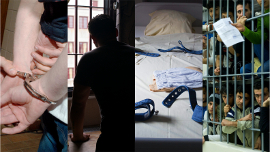As it had been the case in the course of the previous CPT’s visit to Montenegro in September 2008, its delegation received many allegations of deliberate physical ill-treatment by police officers of persons deprived of their liberty. The alleged ill-treatment mainly consisted of slaps, punches, kicks and blows with hard objects by police officers and inspectors inflicted primarily at the time of questioning in police stations. Some detained persons interviewed by the CPT’s delegation also alleged that electric discharge weapons had been used by police officers to apply shocks to them or claimed to have been repeatedly hit with a baseball bat on their chests while wearing a bullet-proof vest in order to make them confess to a crime or to provide information. When met by the CPT’s delegation, several detained persons displayed visible injuries which were consistent with their allegations of physical ill-treatment by police officers. The Committee puts forward concrete recommendations aimed at changing the attitude within the Montenegrin Police towards physical ill-treatment by, inter alia, in-service training and the adoption of whistle-blower protection measures. In their response, the Montenegrin authorities refer to steps taken to introduce specific training modules for police officers on basic rights of detained persons and to allow the monitoring of law enforcement establishments by NGOs.
At the Remand Prison in Podgorica (part of the “Spuž Prison Complex”), the CPT’s delegation received some allegations of physical ill-treatment of inmates by staff. In addition, incidents of inter-prisoner violence and intimidation appeared to be frequent at the Institution for Sentenced Prisoners (KPD) in Podgorica. The CPT recommends in the report that the authorities deliver a firm message to prison staff that physical ill-treatment of inmates is not acceptable and invest more efforts in tackling and eradicating inter-prisoner violence. The Montenegrin authorities provide in their response relevant information on the steps taken to investigate cases of alleged physical ill-treatment described in the report.
As regards material conditions at the prison establishments visited, the report notes the recent efforts invested by the authorities to refurbish several sections of the Remand Prison in Podgorica as well as of the nearby KPD establishment. However, serious levels of overcrowding were observed in all dormitories of Pavilion A of the KPD establishment (with up to 28 inmates accommodated in one dormitory measuring 58m2) and sanitary facilities were found in a deplorable state of repair and hygiene. The Committee calls upon the authorities to renovate the entire Pavilion A of the KPD, reduce occupancy levels in its dormitories and immediately repair its sanitary facilities. In their response, the Montenegrin authorities recount the steps taken to improve material conditions both at the Remand Prison and the KPD establishment in Podgorica.
The Committee also puts forward recommendations in the report to increase health-care staffing levels, to improve medical screening of inmates on admission and to offer prisoners more out-of cell activities, both at the Remand Prison and the KPD.
At the Forensic Psychiatric Unit at Dobrota Special Psychiatric Hospital the CPT’s delegation received no allegations of physical ill-treatment of patients by staff this time. However, the Committee notes that lockable space was still not provided to patients and that both rooms and communal areas remained austere and lacked decoration. Recommendations are also put forward to increase nursing presence at the Forensic Psychiatric Unit and the number of patients taking part in therapeutic and rehabilitative activities. The Montenegrin authorities in their response provide an account of the material improvements introduced at the Forensic Unit, as well as the recent increase in health-care staff.
The report also notes positively that, in contrast with the situation described in the CPT’s report on its 2008 visit, no allegations of ill-treatment of residents by staff were received at the Komanski Most Institution for People with Special Needs. The Committee also welcomes the fact that the establishment, following a complete refurbishment programme, now provided adequate conditions to residents. That said, the CPT puts forward several recommendations aimed at ensuring a better personalisation of the living environment of residents, increasing the number of nurses and improving access to the services of external medical professionals for residents. The Montenegrin authorities in their response refer to steps taken in order to employ additional staff as well as the adoption of individual treatment plans for each resident at the Komanski Most Institution.
The visit report and government response have been made public at the request of the Montenegrin authorities and are available on the CPT’s website: www.cpt.coe.int.
2014 News
The Council of Europe’s Committee for the Prevention of Torture and Inhuman or Degrading Treatment or Punishment (CPT) has published today the report on its second periodic visit to Montenegro, which took place in February 2013 together with the Montenegrin Government’s response.
22/05/2014
- Diminuer la taille du texte
- Augmenter la taille du texte
- Imprimer la page

Preventing torture in Europe
www.cpt.coe.int


